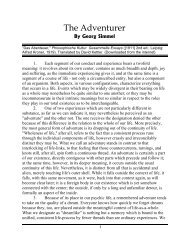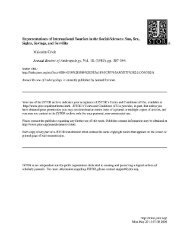The Maya Uay K'ot - OSEA-CITE
The Maya Uay K'ot - OSEA-CITE
The Maya Uay K'ot - OSEA-CITE
Create successful ePaper yourself
Turn your PDF publications into a flip-book with our unique Google optimized e-Paper software.
natural identity as a bird of prey, the myth foregrounds way kot’s other identity as money,<br />
thus pushing the economic logic of the narrative to the surface.<br />
Indeed, the laborers way kot steals are not consumed until after they enter the<br />
realm of production, that is until after the second transaction in which way kot sells his<br />
prisoner to the factory owner. Thus, the myth not only expresses the rural villager’s<br />
antipathy towards industrial wage labor and, perhaps, a latent xenophobia (Sullivan<br />
1989), but reveals the essence of the commodity as congealed laborers, an image which<br />
would surely be the envy of Dali or Miró. Nevertheless, Way Kot is not unlike many<br />
passages of Capital which are so littered with imaginary subjects like Mr. Moneybags<br />
that Marx feels compelled to warn his readers that "the characters who appear on the<br />
economic stage are but the personifications [emphasis added] of the economic relations<br />
which exist between them" (1939: 57).<br />
<strong>The</strong> circuit is then completed when way kot returns from abroad with canned<br />
goods, sewing machines and other foreign products (see especially texts 6 and 30 in<br />
Boccara 1997: 55 and 124). 14<br />
<strong>The</strong> encounter between way kot and his <strong>Maya</strong> victims can also be seen as a<br />
condensed history of productive relations in Yucatán, or what Walter Benjamin<br />
sometimes referred to as a “configuration” or “monad” (see opening epigram), an<br />
arresting mom moment in which the narrator grasps the connection “which his own era<br />
has formed with a definite earlier one” (1977: 263). If, as Michel Boccara suggests, the<br />
tale of Way Kot goes back to the early 19th century, the central drama can be viewed as a<br />
highly cathected image of the notorious sale of <strong>Maya</strong> slaves to Cuba in the 1840s, the<br />
expropriation of <strong>Maya</strong> villagers by henequén producers in the late 1800s, the<br />
intensification of commerce in the 1930s, the migration of braceros (farm workers,<br />
literally “arms”) to the US in the 1940s as well as the ongoing necessity of workers to go<br />
abroad. In fact, one thing Boccara demonstrates quite effectively through his dialogue<br />
with Don Mario, an elder informant, is that Way Kot continues to evolve, incorporating<br />
newer, more ingenious methods of capturing labor as well as more talented evil-doers<br />
(e.g., engineers, intellectuals).<br />
Indeed, in a story reminiscent of the question posed by the inquisitive six-year-<br />
in Ticul, Mario remarks (1997: 157):<br />
old I met<br />
Everyone who has completed advanced studies has researched ways ... to exploit<br />
the people. If they weren’t able to exploit the women, they have sought to exploit<br />
the strength of the peasant. But there are people who ... are nearly the same as<br />
Way Kot. <strong>The</strong>re are many cases like this. <strong>The</strong>y steal the infant and they carry him<br />
away. <strong>The</strong>re are times where they find the person responsible, but sometimes the<br />
child is lost. One time, I don’t know who discovered it, but there was a little child<br />
who had been taken to another country. And when he was grown up, well ... they<br />
injected ampoules into his arms so that he would become clumsy (one armed), so<br />
that he could get handouts, so he could ask for charity. Each day, the child went<br />
out, and when he returned to where the chief who had taken him lived, he gave<br />
him the money, and thus he [the chief] lived on the back of the little child.... Well,<br />
I also think that the Way Kot are like this, lazy people who don’t want to work and<br />
that make money with studies, with their ideas. [Translated from the original by<br />
author.]<br />
E. Commerce and Witchcraft<br />
16




